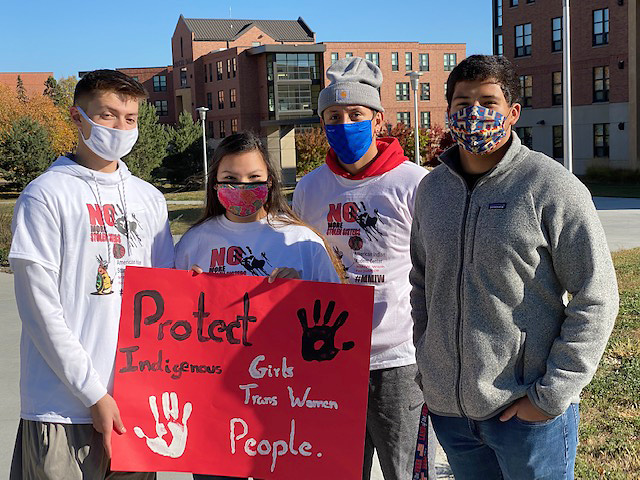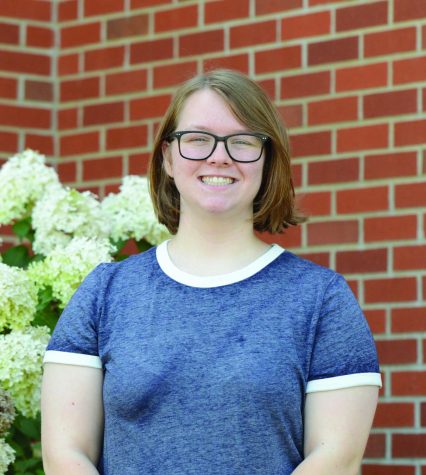Hidden history of missing and murdered Indigenous women
November 4, 2020
In South Dakota, the concept of missing and murdered Indigenous women (MMIW) is not new to most Indigenous peoples throughout the state. In non-Indigenous circles though, many are still unaware of just how prevalent a problem this is.
“Why we know about this is because of Indigenous people raising awareness, because of families talking to other families who are going through a similar thing,” Sharity Bassett, assistant professor of American Indian studies, said. “I’m saddened to say that every day on my Facebook newsfeed there is at least one family putting out a picture of somebody [who has gone missing].”
According to a report issued by the Urban Indian Health Institute (UIHI) in 2019, 506 cases of missing and murdered Indigenous women and girls were collected and identified across 71 cities in 29 states. One hundred-twenty-eight of those cases involved an Indigenous woman going missing and 280 were cases of Indigenous women being murdered. Ninety-eight cases were of an unknown status. Additionally, 13 of those 506 cases occurred in South Dakota.
The median age of women among these cases was 29 years old. The youngest case involved an infant less than 1 year old, and the oldest case involved an 83-year-old woman. Twenty-seven percent of the cases involved someone 18 years old or younger.
The information was gathered from a variety of sources, including police reports, state and national databases, media coverage, social media and accounts from community and family members. Though data was requested by UIHI from as far back as 1900, 80% of the data collected had occurred since 2000.
“It’s scary for me just being Indigenous, knowing that’s something that can happen and knowing a lot of the crimes aren’t taken seriously,” Paige Cain, a junior studying history education and American Indian studies, said. Cain has researched MMIW over the last three years. She is also a tribal descendant of the Flandreau Santee Sioux Tribe.
According to her research findings, Indigenous women face sexual assault rates nearly 10 times that of the national average. Bassett added that in most demographics, 80% of sexual violence is committed by someone of the same race or ethnic group as the victim; with Indigenous women, the majority of these attacks are committed by a non-Indigenous perpetrator.
These official numbers are only a fraction of the number of cases that occur. Cain explained that very few cases of MMIW end up in some sort of database. In 2016, 5,712 cases such as these were reported. Only 116 of those cases ended up in a national database.
It is also challenging to get state and tribal governments to share information about MMIW, which makes getting an accurate count of total cases difficult. South Dakota also has no database for cases regarding MMIW.
“There are some things with state versus tribal law that make it near impossible to prosecute people who are not Indigenous but committed a crime on Indigenous lands,” Megan White Face, program coordinator for the SDSU Wokini Initiative said. “There are all these crazy laws that exist to protect us, but [also] to protect non-Indigenous people from us.”
Indigenous scholars are working to address the alarming frequency of indigenous victims compared to other demographics.
Audra Simpson, Kahnawake Mohawk cultural anthropologist, believes it comes from the cultural and spiritual ties Indigenous people have to the land. Colonists needed to remove them so they could take that land for themselves. Indigenous women in particular were susceptible to this.
“Historically, our communities were matriarchal. Women weren’t necessarily leaders but had very high positions in the community …,” White Face said. “So, removing the women definitely does damage to the community.”
Sarah Deer, University Distinguished Professor at the University of Kansas, speaks of how colonization can be directly linked to why Indigenous women are raped and murdered in current culture. She has demonstrated through her research that before colonization, rape was not a concept among most Indigenous tribes in North America. She also explains that while MMIW have been labeled an “epidemic,” in our culture, the rape of Indigenous women has stretched back several centuries, historically being used as a tool to aid in the genocide of Indigenous peoples.
In recent history, White Face explains that the negative stereotypes people can have of Native communities, especially those in tribal communities, also influences why many cases aren’t taken seriously.
“In my experience with women and people I’ve known in the past that have faced any kind of tragedy, whether it’s a death or abuse, most people’s first reaction is ‘well, it’s because they’re an alcoholic or they abuse drugs or they’re homeless,’” she said. “I know that’s sometimes the case, but that doesn’t mean they’re not of value.”
SDSU has done work to address this problem through the American Indian Student Center. The AISC recently sponsored the “Missing and Murdered Indigenous Women Walk for Justice,” which Bassett said had a turnout of nearly 100 people. The event hosted speakers including Cain, who discussed the historical contexts of missing and murdered Indigenous women, and dancers performing a jingle dress dance, an important cultural tradition meant to be a dance for healing.
Morgan Catlett-Ausborn, the American Indian Student Academic and Student Success adviser, said that they hope to continue hosting events like the walk in the future to continue spreading awareness.
“We really want to bring more focus to that specific subject because it is so important and so many people are affected by it, and use that as a jumping-off point to discuss even broader topics of the health and wellness of women,” she said.
The AISC plans to host a variety of talks in the future that, while not specifically about MMIW, discuss factors that contribute to the problem. White Face added that a speaker, American Indian health psychologist and musician Darryl Tonemah, will speak about the trauma in Native communities and how this has affected Indigenous peoples at a biological level Nov. 16 via Zoom.
Overall, those close to this issue want non-Indigenous people to know that these are serious issues that require open-mindedness and understanding.
“We’re often overlooked because of the way we live, and people don’t see us in a scholarly way, don’t see us as educated, intelligent, worldly people,” White Face said. “People think, especially perpetrators, it’s easy to come to our reservations and do harm to our community and no one will care, when in fact it’s the exact opposite.”

























